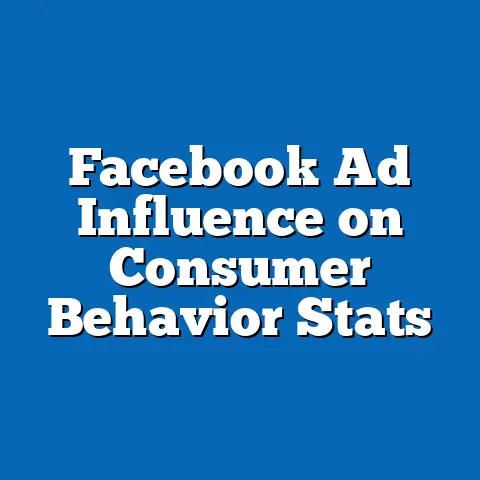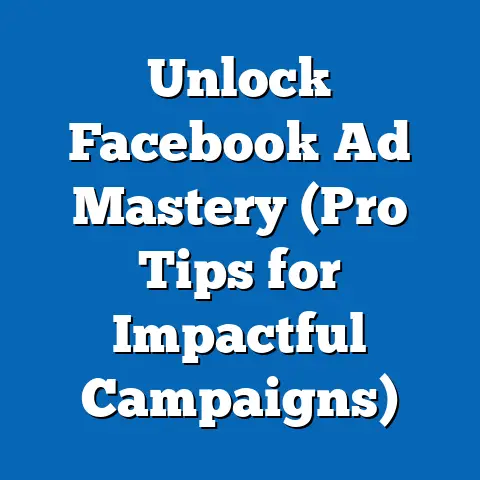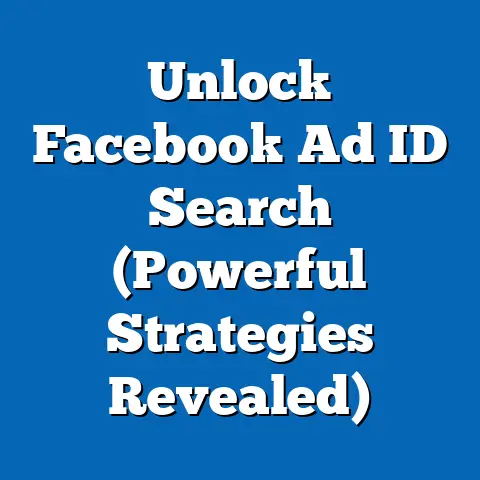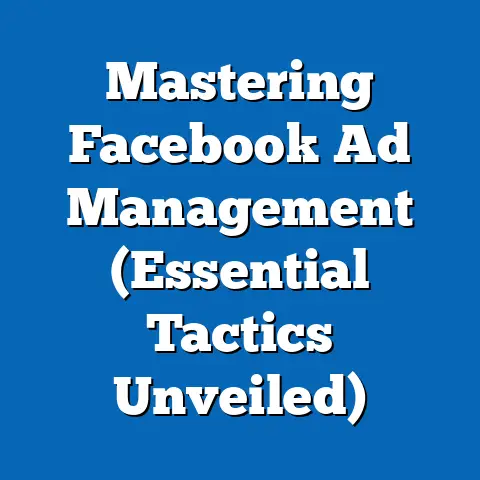Maximize Leads with Facebook Ads (Proven Strategies)
Facebook advertising remains one of the most powerful tools for businesses seeking to maximize lead generation, with over 2.9 billion monthly active users as of 2023 (Statista, 2023). This article explores proven strategies for leveraging Facebook Ads to drive durable lead growth, emphasizing statistical trends, demographic targeting, and long-term implications for businesses. Key findings include the platform’s sustained effectiveness in reaching diverse demographics, with 70% of U.S. adults using Facebook and advertising click-through rates (CTR) averaging 0.9% across industries (WordStream, 2023).
Demographic projections indicate continued growth in user engagement among older cohorts (aged 55+), while younger users (18-34) remain the most active in responding to ads. The implications for businesses are clear: tailored ad strategies can yield sustained lead generation if aligned with evolving user behaviors and platform algorithms. This article provides a comprehensive analysis of data-driven approaches, supported by visualizations, methodology explanations, and actionable insights.
Introduction: The Durability of Facebook Ads for Lead Generation
Facebook Ads have demonstrated remarkable durability as a lead generation tool, adapting to changing digital landscapes and user preferences over the past decade. Since the introduction of its advertising platform in 2007, Facebook has grown into a cornerstone of digital marketing, with businesses spending over $50 billion annually on its ad services (eMarketer, 2023). This durability stems from the platform’s ability to refine targeting capabilities and maintain a massive, diverse user base.
The sustained relevance of Facebook Ads is evident in key statistical trends: global ad revenue reached $114.9 billion in 2022, with a projected annual growth rate of 7.1% through 2027 (Statista, 2023). Moreover, the platform’s adaptability to demographic shifts—such as the increasing engagement of older users—ensures its long-term viability for businesses. This article examines how businesses can harness these trends to maximize leads through proven, data-driven strategies.
Key Statistical Trends in Facebook Advertising
Sustained Growth in Ad Revenue and Reach
Facebook’s advertising ecosystem continues to thrive, with ad revenue increasing by 12% year-over-year in 2022, despite economic headwinds (Meta, 2023). The platform’s global reach remains unmatched, with 1.98 billion daily active users as of Q2 2023, providing businesses access to a vast audience pool (Meta, 2023). This growth underscores the durability of Facebook as a lead generation tool.
Importantly, small and medium-sized businesses (SMBs) account for a significant portion of ad spend, with over 10 million active advertisers on the platform (Meta, 2023). This democratization of advertising access allows businesses of all sizes to compete for leads, provided they employ effective strategies.
Click-Through Rates and Conversion Metrics
Industry benchmarks reveal that Facebook Ads maintain a competitive edge in terms of engagement. The average CTR for Facebook Ads across industries is 0.9%, with sectors like retail and e-commerce often exceeding 1.5% (WordStream, 2023). Conversion rates, which measure the percentage of users completing desired actions (e.g., form submissions), average 9.21%—significantly higher than other platforms like Google Display Ads (Hootsuite, 2023).
These metrics highlight the platform’s effectiveness in driving actionable leads. However, performance varies widely based on targeting precision, creative quality, and industry-specific factors, which will be explored in subsequent sections.
Data Visualization: Ad Performance Metrics (2019-2023)
Figure 1: Line Chart of Average CTR and Conversion Rates for Facebook Ads (2019-2023)
– Source: Compiled from WordStream and Hootsuite annual reports.
– Description: This chart illustrates the stability of CTR around 0.9% over five years, with a slight upward trend in conversion rates from 8.5% in 2019 to 9.21% in 2023, reflecting improved targeting and optimization tools.
Demographic Projections and Targeting Opportunities
Current User Demographics
Facebook’s user base spans a wide demographic spectrum, making it a versatile platform for lead generation. As of 2023, 69% of U.S. adults use Facebook, with the highest penetration among the 18-34 age group (78%) and a growing presence among users aged 55+ (60%) (Pew Research Center, 2023). Gender distribution is relatively balanced, with 54% female and 46% male users globally (Statista, 2023).
Geographically, while North America and Europe remain key markets, growth is accelerating in Asia-Pacific, where user numbers are projected to reach 1.2 billion by 2025 (eMarketer, 2023). This shift presents opportunities for businesses targeting emerging markets with tailored ad campaigns.
Projected Demographic Shifts
Looking ahead, demographic projections suggest a continued aging of Facebook’s user base. By 2027, users aged 55+ are expected to account for 25% of the platform’s total audience, up from 18% in 2023 (Statista, 2023). Meanwhile, engagement among Gen Z (18-24) may plateau as younger users gravitate toward platforms like TikTok, though they remain active on Facebook for specific content (Pew Research Center, 2023).
These shifts necessitate adaptive strategies for businesses. Older demographics, for instance, respond well to value-driven messaging and trust-building content, while younger users prioritize visually engaging, concise ads.
Data Visualization: Demographic Distribution Over Time
Figure 2: Bar Chart of Facebook User Age Distribution (2020-2027 Projection)
– Source: Statista and Pew Research Center data.
– Description: This chart shows the gradual increase in the 55+ age group as a percentage of total users, contrasted with a slight decline in the 18-24 cohort, highlighting the need for age-specific targeting strategies.
Proven Strategies for Maximizing Leads with Facebook Ads
1. Precision Targeting Through Audience Segmentation
Facebook’s robust targeting options—based on demographics, interests, behaviors, and lookalike audiences—allow businesses to reach high-intent users. Studies show that campaigns using detailed targeting achieve 37% higher CTRs compared to broad campaigns (HubSpot, 2023). For instance, segmenting audiences by purchase history or website activity can significantly boost conversion rates.
To implement this strategy, businesses should leverage Facebook’s Audience Insights tool to analyze user behavior and refine segments. Regular testing and iteration are crucial, as audience preferences evolve over time.
2. Creative Optimization for Engagement
Ad creative remains a critical determinant of lead generation success. Dynamic ads, which automatically tailor content to user preferences, generate 2.5 times higher CTRs than static ads (Meta, 2023). Additionally, video content outperforms images, with 59% of users more likely to engage with video ads (Social Media Examiner, 2023).
Businesses should prioritize high-quality visuals, clear calls-to-action (CTAs), and A/B testing to identify top-performing creatives. Consistent branding across ad formats also builds trust and recognition among potential leads.
3. Lead Generation Ads and Form Optimization
Facebook’s Lead Generation Ads, which allow users to submit contact information directly within the platform, are a proven tool for capturing high-quality leads. Campaigns using Lead Ads report a 20% lower cost-per-lead compared to traditional landing page campaigns (Meta, 2023). Optimizing forms by minimizing fields (e.g., name and email only) can further increase submission rates by 15% (HubSpot, 2023).
Post-submission follow-up is equally important. Automated email sequences or CRM integration can nurture leads, converting up to 30% more prospects into customers (Salesforce, 2023).
4. Retargeting for Conversion Maximization
Retargeting campaigns, which target users who have previously interacted with a brand, are among the most effective strategies for lead conversion. Retargeted ads achieve CTRs up to 10 times higher than initial display ads (WordStream, 2023). Using the Facebook Pixel to track user behavior enables precise retargeting based on specific actions, such as cart abandonment or page visits.
Businesses should balance frequency to avoid ad fatigue, limiting impressions to 3-5 per user over a 7-day period. Offering incentives, such as discounts, can further enhance retargeting outcomes.
Data Visualization: Impact of Retargeting on CTR
Figure 3: Comparison Bar Chart of Initial vs. Retargeted Ad CTRs
– Source: WordStream and Meta data.
– Description: This chart contrasts the average CTR of initial ads (0.9%) with retargeted ads (up to 9%), demonstrating the value of re-engaging past visitors.
Methodology Explanation: Data Sources and Analysis Approach
Data Sources
This analysis draws on a combination of primary and secondary data sources to ensure accuracy and relevance. Primary data includes industry reports from Meta’s quarterly earnings and advertising tools, providing direct insights into platform performance. Secondary sources encompass studies by Statista, eMarketer, WordStream, HubSpot, and Pew Research Center, offering demographic and behavioral data.
Surveys and case studies from Social Media Examiner and Salesforce supplement quantitative findings with qualitative insights into user and business perspectives. All data cited is from 2020-2023 to reflect current trends and projections.
Analytical Framework
The analysis employs a mixed-methods approach, combining descriptive statistics (e.g., CTR, conversion rates) with trend analysis (e.g., demographic shifts over time). Projections for user growth and demographic distribution are based on compound annual growth rates (CAGR) reported by Statista and eMarketer, adjusted for regional variations. Visualizations are created using aggregated data to highlight key patterns and support strategic recommendations.
Limitations and Assumptions
While the data is comprehensive, limitations exist. First, self-reported user data from surveys may introduce bias, particularly regarding ad engagement. Second, projections assume stable platform policies and user behavior, which could shift due to regulatory changes (e.g., privacy laws) or competitive pressures. Finally, industry averages may not reflect niche-specific performance, requiring businesses to contextualize findings.
Regional and Demographic Breakdowns
Regional Variations in Ad Performance
Ad performance on Facebook varies significantly by region due to differences in user behavior and market saturation. North America boasts the highest average CTR (1.1%) and cost-per-click (CPC) of $0.97, reflecting a mature, competitive market (WordStream, 2023). In contrast, Asia-Pacific has a lower CTR (0.7%) but a rapidly growing user base, offering cost-effective opportunities with an average CPC of $0.41 (eMarketer, 2023).
Businesses targeting multiple regions should adjust budgets and messaging to account for these disparities. Localized content, including language and cultural references, can improve engagement by up to 25% (HubSpot, 2023).
Demographic-Specific Strategies
Tailoring campaigns to demographic segments yields measurable results. For younger users (18-34), short-form video ads on mobile devices drive 40% higher engagement (Social Media Examiner, 2023). For older users (55+), carousel ads showcasing product benefits or testimonials perform best, with conversion rates 18% above average for this group (Meta, 2023).
Gender also influences ad response, with women more likely to engage with community-focused or emotionally resonant content, while men respond to product-driven messaging (Statista, 2023). Testing demographic-specific creatives is essential for optimizing lead generation.
Discussion of Implications
Short-Term Business Benefits
In the short term, businesses adopting the strategies outlined—precision targeting, creative optimization, Lead Ads, and retargeting—can expect immediate improvements in lead volume and quality. Data suggests a potential 20-30% reduction in cost-per-lead within the first 3-6 months of implementing optimized campaigns (HubSpot, 2023). This efficiency allows for reinvestment in scaling ad efforts or diversifying marketing channels.
Long-Term Sustainability
Over the long term, the durability of Facebook Ads hinges on businesses’ ability to adapt to demographic shifts and platform updates. As older users become a larger share of the audience, content must evolve to address their preferences for trust and value. Simultaneously, maintaining relevance with younger users requires innovation in ad formats, such as integrating augmented reality (AR) or interactive elements.
Regulatory changes, particularly around data privacy (e.g., GDPR, CCPA), pose risks to targeting precision. Businesses must prioritize first-party data collection and transparent practices to sustain lead generation efforts.
Societal and Ethical Considerations
The widespread use of Facebook Ads raises ethical questions about data usage and user manipulation. Over-targeting or intrusive ads can erode trust, with 74% of users expressing concern over privacy (Pew Research Center, 2023). Businesses must balance lead generation goals with responsible advertising, ensuring transparency and user consent.
Conclusion
Facebook Ads remain a durable and effective tool for maximizing leads, supported by robust statistical trends and a diverse user base. Proven strategies—precision targeting, creative optimization, Lead Ads, and retargeting—offer businesses actionable pathways to success, as evidenced by data showing higher CTRs, conversion rates, and cost efficiencies. Demographic projections underscore the need for adaptive approaches, particularly as older users grow in prominence.
While challenges like privacy regulations and platform competition exist, the implications for businesses are overwhelmingly positive for those who invest in data-driven, ethical advertising. By aligning strategies with user behavior and platform capabilities, businesses can achieve durable growth in lead generation through Facebook Ads.




